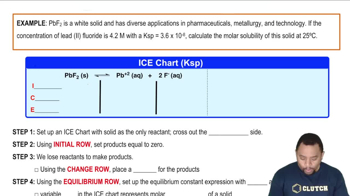Here are the essential concepts you must grasp in order to answer the question correctly.
Molar Solubility
Molar solubility refers to the maximum amount of a solute that can dissolve in a given volume of solvent at equilibrium, expressed in moles per liter (M). It is crucial for understanding how much of a compound can dissolve in a solution, especially when considering the effects of common ions and pH on solubility.
Recommended video:
Solubility Product Constant (Ksp)
The solubility product constant (Ksp) is an equilibrium constant that applies to the solubility of sparingly soluble ionic compounds. It is defined as the product of the molar concentrations of the ions, each raised to the power of their coefficients in the balanced equation. For MnS, Ksp = [Mn^2+][S^2-], and knowing Ksp helps in calculating the molar solubility in different conditions.
Recommended video:
Solubility Product Constant
Buffer Solutions
Buffer solutions are mixtures that resist changes in pH upon the addition of small amounts of acids or bases. In this case, the NH4Cl-NH3 buffer system helps maintain a stable pH, which can influence the solubility of MnS by affecting the concentration of sulfide ions (S^2-) in solution, thereby impacting the equilibrium established by the Ksp.
Recommended video:
 Verified step by step guidance
Verified step by step guidance

